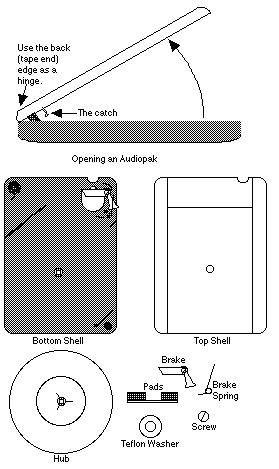Audiopak A-2 (black)

The main competitor of Fidelipac, for many years part of Capitol Magnetics, a direct sibling of the record label which brought us the Beach Boys, Beatles, and Miss Peggy Lee. Capitol Magnetics recently realized that making carts≠making money, and sold the company to the employees. The A-2 is their original NAB A size cart, and is still being manufactured. The original 20 or so carts KALX had up until 1980 were almost all A-2s.
The A-2 takes the novel approach of braking the tape itself, as opposed to the hub. While the claim is that this provides tighter, more reliable cueing, one need only listen to KALX or any other station using Audiopaks to realize that not only is this not so, but if the pads are the least bit marginal, the sound will be very muddy for the first second or two after startup, as the tape bounces on & off the heads. This author believes the primary motivation was patent infringement avoidance. It is interesting to note that latter-day 4-track and almost all 8-track tapes contain no brakes, yet they were meant to spend most of their lives flying around in moving automobiles. Hmmmm…
A-2 parts include the brake arm, brake spring, teflon® washer, and pads, along with the obligatory hub o’ tape and upper and lower shell. Note that the pads attach to the upper shell, and use no glue. With the possible exception of the case screws, no parts are interchangeable with other brands of carts (but see below). There is a hinge mechanism behind the center pad, requiring that any label on the front be cut or removed, and the lid lifted up using the back edge as a hinge. Pulling straight up either won’t work, or will destroy the latch, and thereby the shell.

As with Fidelipacs, pads are essential, washers desirable. The brake pivot pins love to break. Seeing as the brake does so little anyway, go ahead and remove the brake parts if the pivot pins lose it. Also watch out that the copper alloy spring pushes on the brake arm, and not directly on the tape—bad news for the tape. The bottom shell is equipped with a right rear corner guide, just in case you wind up with a little too much tape slack. When reassembling, watch for falling pads and misaligned brake pivot pins, which must mate with holes in the top shell (no comments from you, Mr. Broady). You must hinge the lid down in the exact manner in which you opened it, in reverse.